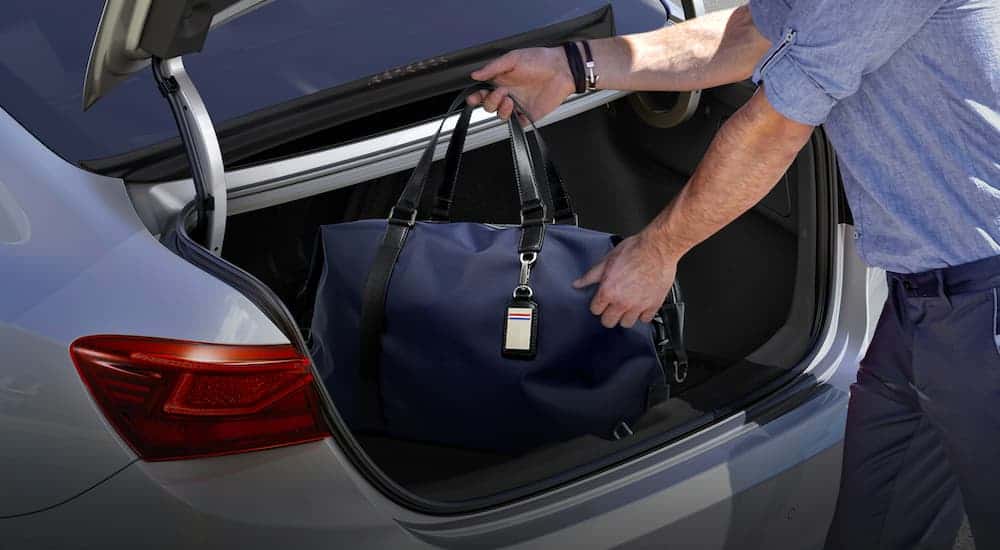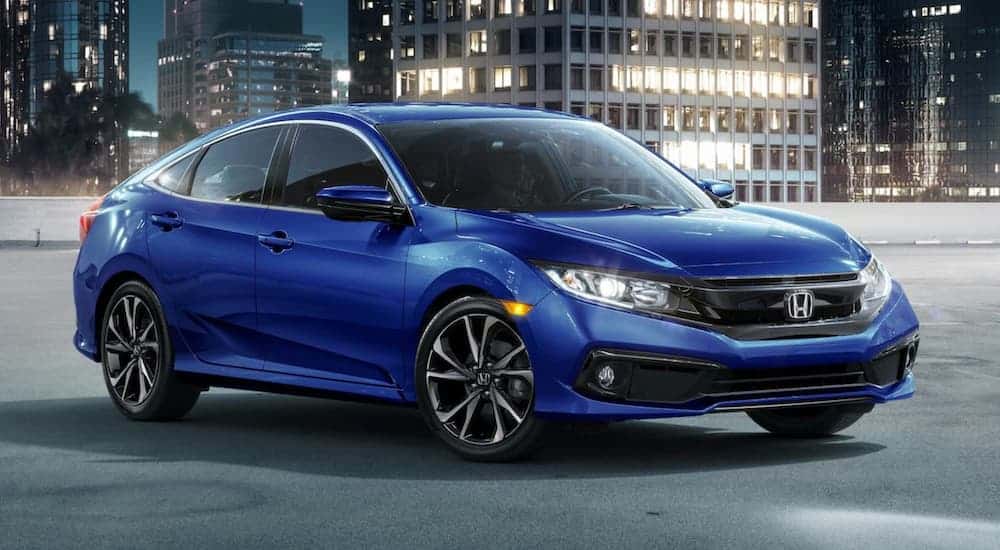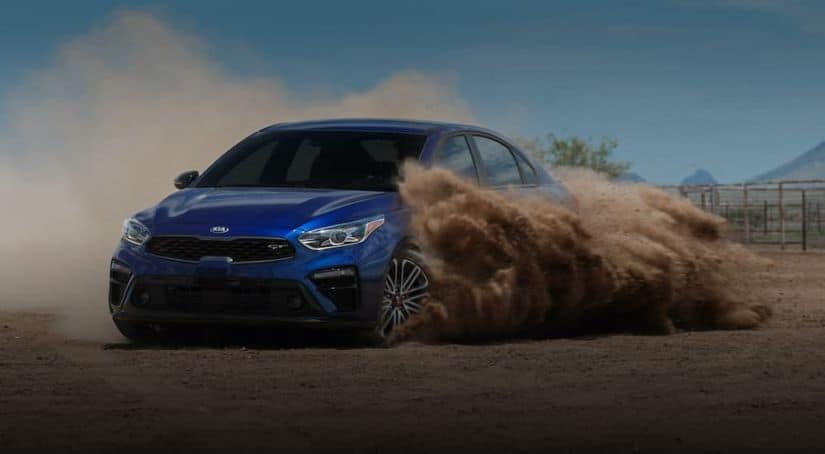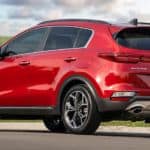Car manufacturers are beginning to take cues from the market and are ending the production of sedans. Some manufacturers have only one line of sedans left, while others have none at all. Here is where Kia and Honda will have an opportunity to fill a gap for the buyers who still prefer a smaller vehicle that is fuel-efficient and affordable. Which of these sedans is better for the money? In comparing the 2021 Kia Forte vs 2021 Honda Civic, features and pricing will show which of these sedans is the better bargain in a shrinking pool of choices.
Pricing and Standard Features
First, the 2021 Kia Forte has a starting MSRP of $17,890. That base price gets you the FE trim, which comes standard with a 2.0-liter four-cylinder engine that gets up to 31 MPG in the city and 41 MPG on the highway. This engine will have a six-speed manual transmission or an Intelligent Variable Transmission. The Forte also has a long list of safety features: forward collision warning, forward collision avoidance, lane departure warning, lane keeping assist, driver attention warning, auto emergency braking, and electronic stability control. A standard eight-inch touchscreen for the infotainment system will come with an integrated rearview camera, Bluetooth, and Apple CarPlay and Android Auto.
Other features standard for the base trim of the Forte are conveniences like two charging ports plus one input jack for smartphones, steering wheel-mounted controls for the audio system and cruise control, a tilting and telescoping steering wheel, three selectable driving modes, powered windows and locks, remote keyless entry, six-way adjustable front seats, solar controlled glass, and projector beam headlights. Additional standard safety features include hill start assist, traction control, electronic brake force distribution, vehicle stability management, and a brake assist system.
The 2021 Honda Civic has a starting MSRP of $21,050, which buys you the LX trim. This trim also comes standard with a 2.0-liter four-cylinder engine, though it has a lower fuel efficiency of 30 MPG in the city and 38 MPG on the highway. There is also no manual option on the Civic, with a continuously variable transmission is standard on every trim. Safety features include road departure mitigation system, lane departure warning, lane keeping assist, forward collision warning, collision mitigation braking, and adaptive cruise control with low-speed follow. The Civic LX only comes with a five-inch touchscreen with an integrated rearview camera and Bluetooth for the infotainment system. No Apple CarPlay or Android Auto for the base trim.
The remaining features for the Honda LX are similar to the Forte FE, with a single port for smartphone connectivity in the front, steering wheel-mounted controls for audio and cruise control, a tilting and telescoping steering wheel, powered windows and locks, remote entry, adjustable driver’s seat, and projector beam headlights. Other safety features for the Civic LX include automatic high-beams, electronic brake distribution, vehicle stability assist, traction control, and brake assist.
Comparing just pricing and base trims, the Kia Forte has a much lower starting price with more technology and a few extra features the Civic does not have. Many of these features may be up to the buyer in terms of importance, but for smartphone connectivity, the Kia has the advantage. Kia also has two more charging ports, which will make a difference in most modern lifestyles if only one phone can be charged at a time in the Honda. For the price, the Kia has better value with a slight advantage with standard tech and a larger touchscreen for infotainment.

Forte Trim Levels and Options
The 2021 Kia Forte comes in six trims: FE, LXS, GT-Line, EX, GT, and GT Manual. In general, each trim builds the number of features that are considered standard equipment for that particular trim, and each trim often adds certain features that can be added as options. To the standard features list in the LXS trim, Kia adds exterior details like a chrome exhaust tip, more paint color choices, and black gloss sport bumper accents. Interior features like a 60/40 split rear seat, soft-touch interior door panels, and another choice of interior color are also added.
Moving up to the GT-Line, a sport grille, side sills, spoiler, heated exterior mirrors, a smart trunk, LED daytime running lights, fog lights, and LED taillights are all standard exterior features. Interior features include more speakers for the audio system, a smart key with push-button start, sport seats with artificial leather, a leather-wrapped steering wheel with a flat bottom, and a leather-wrapped shift knob. More safety features are standard with this trim, such as blind spot collision warning, lane-change assist, and rear cross-traffic collision warning. Options for the GT-Line are UVO e-services, a Harmon Kardon audio system, two USB ports for the center console, and 10-way power front seats with lumbar support.
Once into the EX trim, the features include chrome exterior accents and a powered sunroof, while the interior will include the UVO link with voice-commanded navigation and Sirius XM, the Harmon Kardon audio system, a wireless phone charger, dual-zone climate control, and faux leather seating. With the GT and GT Manual, the emphasis is placed on the sporty appearance like the GT-Line, but it has the added benefit of the more powerful turbocharged 1.6-liter engine, sport-tuned suspension and exhaust, and sport seats with faux leather and red stitching.
Between the two upper trims, one of the main differences is the transmission. For the GT, it’s a seven-speed dual-clutch automatic transmission, while the GT Manual has a six-speed manual transmission, which is meant to add to the excitement of driving a sport-tuned car. Because the Forte was inspired by the Kia Stinger in its design, the compact sedan leans toward a more sporty appearance. Other small differences are the equipment that is standard for the GT Manual and only optional for the GT: the Harmon Kardon audio system, a reverse parking distance warning, and the wireless charger. The climate control reverts to a single-zone manual system for both GT upper trims. Heated and ventilated front seats are available for the GT but not for the GT Manual. However, both upper trims gain a black leather-wrapped steering wheel and shift knob.

Civic Trim Levels and Options
Honda’s 2021 Civic comes in five trim levels: LX, Sport, EX, EX-L, and Touring. To the standard equipment of the base LX trim, the Sport will add Apple CarPlay and Android Auto, a seven-inch touchscreen, HondaLink telematics, push-button start, smart entry, a leather-wrapped steering wheel and shift knob, fog lights, and a decklid spoiler. The EX trim adds SiriusXM satellite radio, HD radio, dual-zone climate control, heated front seats, powered driver’s seat, heated exterior mirrors, and a moonroof. One more safety feature is added with lane watch. For the EX-L, Honda adds only an auto-dimming rearview mirror, leather-trimmed seats, and universal home remote.
Finally, the uppermost trim, the Touring, has standard features that include satellite navigation with voice recognition and traffic link, an upgraded 10-speaker audio system, front and rear heated seats, powered front passenger seat, rain-sensing wipers, and LED headlights. Overall, the features of both sedans are an impressive list of conveniences. Pricing is one of the biggest differences between the two vehicles, with the Forte GT Manual, the top Kia trim, starting at $23,290 while Honda’s top Touring trim starts at $28,100. Kia’s Forte has the GT trims to lend a sporty appearance and driving experience, while the Civic has nothing to offer in this arena after the discontinuation of the sporty Civic Si model.
The Forte Stands Strong
Between the two compact sedans, the Kia Forte will give buyers more vehicle for less money. All the trim levels are less expensive than their counterparts on the Honda Civic, and Kia offers buyers smartphone connectivity standard with every trim. While both sedans have lots of driver-assisted and electronic safety features, the Kia Forte offers a sporty appeal to buyers interested in a vehicle that has a more exciting driving experience, particularly with the GT and GT Manual. Honda has a few extra convenience features in the upper trims that Kia does not include, but they come at a much higher cost.
For the value alone, the 2021 Kia Forte has the biggest advantages in terms of a similar list of features for a much lower price at every trim level. To seal the deal, Kia offers one of the industry’s best warranties. Not only does it last ten years or 100,000 miles, but it’s also far more inclusive than Honda’s five year or 60,000 mile warranty. The Kia wins this comparison of compact sedans, hands down.



